|
|
 |
|
May 31, 2011
When I turned 21 no one gave me a car as a birthday present, although my mother did lend me her ancient Nash Rambler for a few weeks when I was in desperate need of wheels. When Prince Charles celebrated his twenty-first, back in 1969, his mom, Queen Elizabeth, gave him an Aston Martin DB6 Volante Mkll. (I guess that’s one difference between commoners and royalty). Flash forward to April 29, 2011, and if you caught the footage of Prince William taking his new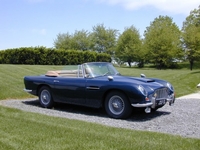 bride out for an impromptu spin in his dad’s car, you saw that it is still a gorgeous machine. Yes, Prince Charles still has his Aston Martin. bride out for an impromptu spin in his dad’s car, you saw that it is still a gorgeous machine. Yes, Prince Charles still has his Aston Martin.
A few years ago, when the makers of Aston Martin heard that the eco-friendly prince wanted to convert his car to bioethanol (his Jaguars, Audi and Range Rovers have all been converted to run on 100% biodiesel made from used cooking oil), they contacted Green Fuels, a biofuels supplier, for help. According to a report in the Daily Mail, Green Fuels bought 8000 liters of surplus white wine from an English winery. They ran the wine through their distillery, and after boiling off the wine’s 11% alcohol, condensing it and removing any remaining water, Green Fuels was left with hundreds of liters of 99.8% pure ethanol. In a new take on the wine-and-cheese-party theme, the ethanol was topped up with alcohol extracted from fermented whey collected from local cheese makers. The Aston Martin’s carburetors were tweaked to allow more fuel into the engine, and vroom vroom--the car was off and running on a mix of 85% ethanol / 15% petrol. Bioethanol, by the way, is only slightly cheaper than conventional fuel, but is estimated to produce 85% less carbon.
The grapes used for the prince’s fuel had already been fermented into  wine. The winery owners bottle all they can, but since they aren’t allowed to produce more than their EU quota, they sell it to Green Fuels rather than destroy the excess (the Daily Mail article reported that the winery’s owner is “keeping his head down for fear of mobs in search of free plonk”). wine. The winery owners bottle all they can, but since they aren’t allowed to produce more than their EU quota, they sell it to Green Fuels rather than destroy the excess (the Daily Mail article reported that the winery’s owner is “keeping his head down for fear of mobs in search of free plonk”).
“Anything that contains alcohol can be distilled in the same way you produce vodka and whisky,” explains James Hygate at Green Fuels. “The only waste is fruit juice, and this is sent off to make biogas for electricity.” So, now I’m wondering if my mother’s old Nash might have run better had I topped the tank off with a bottle of Chardonnay….
Posted by Marguerite Thomas at 2:26 PM
|
|
May 25, 2011
If you ask most wine lovers around the word to draw a mental picture of wine from Chile, they’ll see red. That’s perfectly understandable, since Cabernet Sauvignon was the country’s calling card for the past twenty years. Yet Chile’s dynamic vintners have recently gotten very good at lots of different things, especially fresh, fruity, flavorful white wines that are perfect for spring and summer.
 Chile is a rather small country in terms of land mass, but it has 3,000 miles of coastline along the cool Pacific Ocean providing excellent conditions for making crisp, refreshing whites--precisely the style that predominates these days. Oaky renditions are rare, and almost every wine you’ll find priced in the teens was made with a view to retaining freshness by fermenting in stainless steel, bottling early, and sealing with a screw cap. Chile is a rather small country in terms of land mass, but it has 3,000 miles of coastline along the cool Pacific Ocean providing excellent conditions for making crisp, refreshing whites--precisely the style that predominates these days. Oaky renditions are rare, and almost every wine you’ll find priced in the teens was made with a view to retaining freshness by fermenting in stainless steel, bottling early, and sealing with a screw cap.
Fruit exporting is a mainstay of the Chilean economy, and winemakers seem to have gotten a message: Fiddle with reds if you want, but with whites, keep them fresh and ship them fast. Southern hemisphere harvests happen in the first half of the calendar year, so you’ll find stores already stocked with whites from 2010. Three crisp cases in point are:
Viña Falernia, Elqui Valley Sauvignon Blanc Reserva 2010, $12 (imported by Empson), featuring energetic aromas and flavors of dried herbs, ripe grapefruit and juicy white melon. Perfect for shellfish or simple fish preparations.
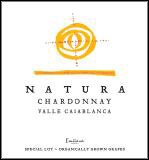 Cono Sur, Central Valley Riesling 2010, $10 (imported by Vineyard Brands), with just a bit of juicy sweetness woven into tropical fruit that finishes with a refreshing snap of citrus acidity. Great for relaxed sipping, or pair with almost any lightly spicy food. Cono Sur, Central Valley Riesling 2010, $10 (imported by Vineyard Brands), with just a bit of juicy sweetness woven into tropical fruit that finishes with a refreshing snap of citrus acidity. Great for relaxed sipping, or pair with almost any lightly spicy food.
Emiliana, Casablanca Valley Chardonnay “Natura” 2010 ($10, imported by Banfi), an un-oaked, organically made Chardonnay that is so vivid it tastes like a delicious fruit salad in a glass. Cold Asian noodle dishes, white meats or crab salad will sing with this.
Posted by Michael Franz at 8:32 AM
|
|
May 24, 2011
Wine is a sensory pleasure. Of the five senses, smell and taste obviously come first in providing that pleasure. The tactile sensation of a wine in your mouth matters less, but it countsm too.
The other two senses, though, play only minor roles. If involved at all, what you hear bespeaks anticipation (rather than gratification). Think of the pop of a Champagne cork, and then the fizz when the wine is poured; those sounds can make your mouth water.
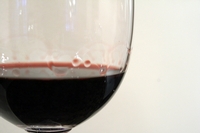 Sight can provide similar pleasures. After all, a half-filled crystal glass is aesthetically attractive. Yet how a wine sounds or looks has very little to do with how it smells or tastes. Sight can provide similar pleasures. After all, a half-filled crystal glass is aesthetically attractive. Yet how a wine sounds or looks has very little to do with how it smells or tastes.
That’s why no one talks much about listening to wine. What is surprising, however, is that people expend lots of energy talking about how wine looks. Why?
Many important professional wine competitions require that up to a quarter of a wine’s score (often five out of twenty points) be determined by sight. Virtually every “how to enjoy wine” book or article begins by advising the reader to analyze a wine’s appearance. And at virtually every wine class I’ve taught over the years, someone has raised a hand and asked about a wine’s “legs”—the viscous droplets on the inside of a glass, something experienced solely though sight, and something that has absolutely nothing to do with the pleasure provided by the senses of smell and taste. Why?
My guess is that the explanation has something to do with the wealth of words we have to detail what we see as compared to our language’s impoverished ability to describe what we experience via nose and mouth. With smell and taste, we often are reduced to bland subjective pronouncements, “I like it” becoming synonymous with “it’s good.”
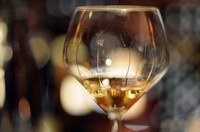 By contrast, with sight we can discriminate linguistically between subtle nuances of color, size, and shape, and so pretend to some semblance of objectivity. So phrases such as “it’s golden yellow,” or “the legs are thick,” or “it’s dark and opaque” seem to have less to do with individual preference and more to do with the wine itself. By contrast, with sight we can discriminate linguistically between subtle nuances of color, size, and shape, and so pretend to some semblance of objectivity. So phrases such as “it’s golden yellow,” or “the legs are thick,” or “it’s dark and opaque” seem to have less to do with individual preference and more to do with the wine itself.
The problem is that golden yellow, thick legs or dark color, have virtually nothing to do with what really counts—how the wine smells and tastes. A golden wine may be evidence of oxidation, of wood aging, of skin contact, of the grapes themselves, and a host of other possibilities—so many that as objective evidence, it’s just about meaningless.
So, too, thick legs dripping slowly down the glass can come equally well from a rich, high alcohol wine and a lithe delicate one. And a dark wine can taste thin and watery just as a light-colored one can taste deep and rich.
The point is that how a wine looks is largely irrelevant. So don’t waste time thinking or talking about it. Instead, devote your words to your more important but admittedly more difficult to discuss senses. With wine, they’re what really matters.
Posted by Paul Lukacs at 10:38 AM
|
|
May 23, 2011
I’ll admit that shoes and wine don’t generally come to mind as typical made-for-each-other partners. The best-known historical example of the two things working together has to do with drinking Champagne from a lady’s slipper. Sweet, but does anyone do that kind of stuff these days? I recently learned about a more contemporary merger between shoes and wine, which struck me as a story worth passing along.
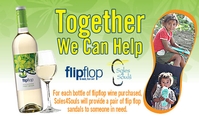 Soles4Souls is an international charity dedicated to providing free footwear to people in need. It was founded in 2004 by a man named Wayne Elsey, who was at that time an executive in the footwear industry. Soles4Souls is an international charity dedicated to providing free footwear to people in need. It was founded in 2004 by a man named Wayne Elsey, who was at that time an executive in the footwear industry.
“I was home in Nashville Tennessee one day, lying on my couch watching the TV coverage of the tsunami disaster in Indonesia,” Elsey told me over lunch in Manhattan last week. “Suddenly there was a picture of a single child’s shoe washed up on the beach. When I saw that something just snapped in me. I knew I had to do something.”
What Elsey did was to start calling friends and colleagues in the footwear industry asking them to help him raise donations of shoes to send to the devastated country. Then, when Hurricane Katrina hit New Orleans Elsey went into action again, but he knew this time that it wouldn’t be a one-shot effort: From now on he was going to devote his life to getting shoes to the millions of people across the globe who cannot afford them.
There are more than 300 million children in the world who are shoeless, Elsey explained, adding that the risk of going barefoot includes the obvious problem of infections brought on by external injury, but also the risk of infection by hookworm and other parasites.
 He told me that Soles4Souls distributes one pair of shoes somewhere in the world every 7 seconds. He also mentioned that flip-flops are the most purchased style of shoe globally--and this is where the wine connection comes in. He told me that Soles4Souls distributes one pair of shoes somewhere in the world every 7 seconds. He also mentioned that flip-flops are the most purchased style of shoe globally--and this is where the wine connection comes in.
Flipflop is the latest label launched by Underdog Wine Merchants, whose portfolio also includes Cupcake Vineyards and Big House. In early 2011 flipflop entered into a partnership with Soles4Souls, with the goal of donating one pair of flip-flop sandals for every bottle of wine purchased.
Flipflop winemaker David Georges (whose resume includes a stint at Davis Bynum winery) told me that his goal at flipflop is to make wines that “maintain good varietal character, are expressive and well balanced, and are affordable to people at all economic levels. I want these to be wines that reflect today’s casual lifestyle.”
After tasting each of the wines I would say that Georges had pretty much achieved his goal. I particularly like the appely/lemony Chardonnay, with its discreet wisp of creamy oak, and the Pinot Grigio, which is relatively fruity and fleshy (and, incidentally, is delicious with grilled seafood).
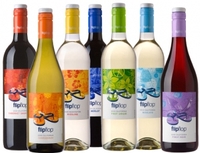 The Merlot is plummy and soft, with enough character to remain interesting through an entire meal, the Cabernet has varietally authentic hints of dark fruit and spice, and the Pinot Noir has more genuine personality than most run-of-the-mill inexpensive California Pinots. Approximately $7 a bottle, with screwcap closures and bright-colored labels, these are casual wines to have fun with at casual events, and you might like them even more knowing that each bottle you purchase helps put shoes on needy feet. The Merlot is plummy and soft, with enough character to remain interesting through an entire meal, the Cabernet has varietally authentic hints of dark fruit and spice, and the Pinot Noir has more genuine personality than most run-of-the-mill inexpensive California Pinots. Approximately $7 a bottle, with screwcap closures and bright-colored labels, these are casual wines to have fun with at casual events, and you might like them even more knowing that each bottle you purchase helps put shoes on needy feet.
And if you really want to put your own best (flip-flop clad) foot forward, Elsey suggests you take a look at all the shoes cluttering up your closet. Ship the ones you don’t wear (no matter how beat-up they might be) to Soles4Souls, which also runs a global micro-enterprise program designed to provide people in developing nations with the resources to start and maintain their own business reconditioning and selling old shoes.
“All those old shoes in your closet could help a mother of five in Haiti support her family,” says Elsey. I’ll raise a glass of flipflop Chardonnay to that!
Posted by Marguerite Thomas at 9:05 AM
|
|
May 21, 2011
One of the most enduring myths of wine appreciation is the quaint notion of room temperature. If you have even a passing interest in wine, you have no doubt heard it said that red wine should be served at "room temperature."
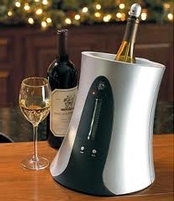 I have a problem with that, and as the days grow warmer with the onset of summer, so should you. It is my considered opinion that the enophile who first set forth the "room temperature" commandment must have lived in a dungeon. I have a problem with that, and as the days grow warmer with the onset of summer, so should you. It is my considered opinion that the enophile who first set forth the "room temperature" commandment must have lived in a dungeon.
Why is this important? Unless you keep your thermostat at a chilly 64 degrees Fahrenheit year-round, room temperature red wines could leave a bad taste in your mouth more often than not. This is especially true if you are prone to cut the air conditioning and throw open the windows on a warm summer day.
Take a popular red such as Cabernet Sauvignon. If served at a temp in the mid-to-high 70s, it can taste astringent and lacking in fruit or otherwise be dull, flabby and boring. The optimum temperature for Cabernet is between 64 F and 66 F. Pinot Noir and lighter reds, such as Chianti and Beaujolais, are more enjoyable at even cooler temps.
Serving a red wine too warm diminishes your pleasure and isn't fair to you or the wine, especially an expensive wine. The worst offenders are restaurants. Anyone who has dined out in summer has likely been presented a bottle that seemed warm to the touch. This is especially true in Europe, where so many restaurants operate without air conditioning, but it happens throughout the U.S., as well.
The easiest and quickest solution is to ask for an ice bucket. Don't be intimidated by the frown of the waiter. Ten minutes in a bucket of ice will do wonders for that warm Merlot. If by chance you give it too much of a chill, no worries: The wine will quickly warm back up to the proper temperature on a summer day.
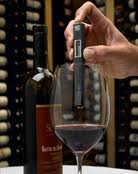 One easy way to test the theory about serving temperature is to organize a blind tasting of several red wines. Put the same wine in the blind tasting twice, but make sure one of them is served cool and the other served warmer than the optimum. Tasters would be hard pressed to identify the identical wines as the same wine when tasted at different temps. And they would almost certainly prefer the cooler wine rather than the warmer wine. One easy way to test the theory about serving temperature is to organize a blind tasting of several red wines. Put the same wine in the blind tasting twice, but make sure one of them is served cool and the other served warmer than the optimum. Tasters would be hard pressed to identify the identical wines as the same wine when tasted at different temps. And they would almost certainly prefer the cooler wine rather than the warmer wine.
Temperature can be just as important for white wines, as well. Crisp, high acid whites are best served very cold. That preserves the essence of their appeal. A Gruner Veltliner, Albarino or Pinot Grigio served too warm will seem flabby and lacking in character.
On the other hand, more full-bodied whites, such as Chardonnay or Riesling, will seem closed and less flavorful if served too cold. The complexities of these wines only begin to emerge as the wine warms in the glass. To my palate, 48-50 F is an ideal temp for Chardonnay and Riesling. Crisper, lighter whites should be served even colder.
Of course, it all comes down to taste, and you should play with the possibilities and find the correct temp for what you like.
Room temperature, after all, should be wherever you decide to set the thermostat.
Posted by Robert Whitley at 5:19 PM
|
|
May 18, 2011
There’s an old saying for contests that have degraded into mismatches: “If it were a fight, they’d have had to stop it.” An intensive series of tastings in Italy last week convinced me that one of the most important contests in the world of wine has indeed degraded into a mismatch, and I’m here to stop it.
The contest I have in mind involves the great contenders for the title of world’s Top Middleweight, by which I mean medium-bodied red wine, which is the most important of all wine categories for those of us who care about wine as a partner for food. I enjoy all sorts of wines with different foods, but the most versatile wines of all are medium-bodied reds, as they can pair up with red meats but also white meats, poultry, pasta dishes, hearty preparations of fish, and many other foods. which is the most important of all wine categories for those of us who care about wine as a partner for food. I enjoy all sorts of wines with different foods, but the most versatile wines of all are medium-bodied reds, as they can pair up with red meats but also white meats, poultry, pasta dishes, hearty preparations of fish, and many other foods.
For years there’s been a tussle at the top of that category between Pinot Noir from Burgundy and Nebbiolo-based wines from Piedmont, but it is no longer a fair fight. Burgundy is down for the count after a one-two punch from the Killer B’s: Barolo and Barbaresco.
My point is not that red Burgundy is in qualitative decline, because it isn’t. The past decade has seen excellent red Burgundy vintages in 2000, 2002, 2005 and 2009. The problem is, rather, that Burgundy’s rarity and international reputation have jacked prices for its better wines up to uncompetitive levels for the vast majority of wine lovers.
If you want delicious red Burgundy, you can find lots of them from the 2009 vintage, but you’d better be prepared to spend $70 to $150. If you’ve got less than $50 per bottle for buying Burgundy, your prospects for getting really good wine are pretty bleak, and you should seriously consider voting with your feet and walking over to the Piedmont section of your favorite wine shop.
Burgundy may have just completed a good decade, but Barolo and 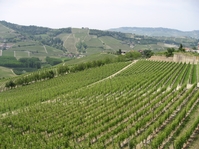 Barbaresco had an even better one, with excellent vintages in 2000, 2001, 2004, 2006 and 2007, very strong vintages in 2005, 2007 and 2009, and a good year in 2008. Despite this amazing run, prices have held steady for the wines, and they are now better at any given price--actually much better--than comparably priced Burgundy. Barbaresco had an even better one, with excellent vintages in 2000, 2001, 2004, 2006 and 2007, very strong vintages in 2005, 2007 and 2009, and a good year in 2008. Despite this amazing run, prices have held steady for the wines, and they are now better at any given price--actually much better--than comparably priced Burgundy.
This is true at almost any price point, but it is absolutely true in the crucial zone between $30 and $50, which is where most devoted wine lovers are comfortable buying wine on a fairly regular basis. You can test this yourself in a matter of minutes by surfing the web to compare what you can get from national caliber wine retailers for any dollar amount in that range.
From Burgundy, you’ll be limited mostly to rather thin, un-sexy village-level wines rather than single-cru wines from top producers. If you are really lucky and are scraping against that $50 ceiling, you might get a mongrelized Premier Cru wine cobbled together by a negociant from different parcels in a village like Gevrey-Chambertin or Volnay. From Barolo and Barbaresco, however, you’ll have many terrific wines to choose from that were made by top producers from the best single vineyards in all of Piedmont. And while you’re at it, check the point scores that most retailers use to help sell the wines. You’ll see that very few Burgundies crack into the 90s in this price range, whereas many Barolos and Barbarescos rated at 93 or 94 points (by the same publications) can be purchased for $50 or less.
I’m willing to acknowledge that there are still some good red Burgundies available for $50 or less. Indeed, you’ll find that Wine Review Online is a stellar source for finding them, as our Michael Apstein tastes there three or four times each year, and he recommends reasonably affordable wines as well as stunning Grand Cru bottlings. If you love red Burgundy and are willing to work at finding the best of the breed at lower price points, your situation is not totally hopeless.
Nevertheless, if you have an open mind and palate and haven’t been blinded by Burgundy’s mystique, I’m certain that you can find wines with much more complexity, character and consistency for the money 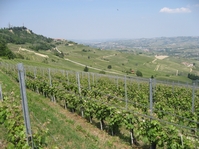 from Barolo and Barbaresco. from Barolo and Barbaresco.
I love red Burgundy as much as anyone alive, but not enough to pay $125 to get one that can measure up to a Barolo that I can buy for $45. That’s a highly realistic comparison these days, which is to say once again: This is no longer a fair fight, and I--for one--have turned my attention to Piedmont.
Following up on this posting (which is partly a personal screed, but mostly an objective report from a taster who loves Burgundy as much as Barolo), I’ll be back in three weeks with dozens of amazing cases in point among 2007 Barolos and the 2008 Barbarescos. If you wish to argue the point between now and then, please write to me at mfranz@winereviewonline.com
Posted by Michael Franz at 7:42 AM
|
|
May 17, 2011
Ernest Cockburn once famously declared “the first duty” of any port wine “to be red.” Contemporary consumers and critics apparently agree. Whether ruby or tawny, blended or vintage, virtually all the ports that people value these days come colored red. We Americans buy some forty bottles of red port for every one of white, and most commentary includes just a cursory sentence or two on white, while devoting page after page to the various categories of red. Yet plenty of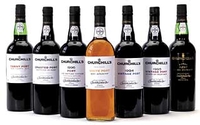 white grapes grow in Portugal’s Duoro Valley, and some 13% of port production consists of white wine. What is it good for? white grapes grow in Portugal’s Duoro Valley, and some 13% of port production consists of white wine. What is it good for?
Well, to be honest, not all that much. A glass of white port, often served chilled, is a popular aperitif along the Duoro. Its appeal, however, has more to do with local pride than inherent quality. Sipped on its own, white port tastes like a slightly sweet version of fino sherry, but rarely exhibits that Spanish specialty’s nuance or subtlety. Since good sherry costs scarcely more, why bother with the port?
One answer is that, while usually unexciting as a stand-alone wine, white port can make a terrific cocktail (or quasi cocktail, if you insist that a true one must include a high-octane spirit). Mixed with fruit juice, club soda, lemonade, or the like, it produces an extremely refreshing drink. Fairly low in alcohol, these tasty concoctions can be great choices for warm weather sipping.
The managers of the various port houses realize as much, and actively promote using white port in lieu of more potent spirits like gin, vodka, or whiskey. Summer in the Duoro can be blazing hot, and the managers have a point: Come the first hint of cool in the evening, a tall white port cocktail does indeed taste heavenly.
The most popular white port drink, and my personal favorite, is the “port-tonic.” Make it just as you would a gin or vodka tonic, though feel free to use half again as much port. (At seventeen or eighteen percent alcohol, it’s far less heady than those spirits.) And in my experience, a wedge or twist of lemon works better than a squeeze of lime. Serve it in a tall glass over ice. Then sit back, relax, and remember--the real duty of any wine is to be enjoyed.
Posted by Paul Lukacs at 6:40 AM
|
|
May 16, 2011
“Sleep - the most beautiful experience in life - except drink.” This quote, from that old rascal WC Fields, came to mind last week during a visit to Portugal, which was hosted by the Esparão wine company. In the three different wine centers I visited (Alentejo, the Douro, and Villa Nova de Gaia/Porto) I lived Fields’ dream-come-true since I indulged in both sound sleep and excellent wines. Should you find yourself in Portugal’s wine country in the near future, let me briefly describe the noteworthy places whose peaceful atmosphere, exceptionally comfortable beds and unusually attractive décor were all conducive to catching plenty of zzz’s at the end of busy days on the wine trail. Each of these hotels offers the creature comforts one expects from a boutique hotel (wireless internet connection in all guest rooms, air conditioning, tennis court, fitness facility, swimming pool, full-service spa, friendly staff, fine dining, etc.)
Convento do Espinheiro: Located in the Alentejo wine region about 90 miles inland from the Lisbon airport, this beautifully restored 15th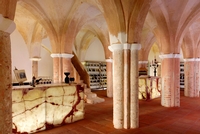 century convent has a wealth of distinctive charms, such as a gorgeously restored chapel (where a string quartet performed the night I was there), and a large expanse of kitchen and flower gardens. The ancient whitewashed, red tiled buildings and tranquil rural setting all transmit an almost palpable sense of serenity. The hotel is about a mile from the lovely town of Evora, a UNESCO Heritage site. century convent has a wealth of distinctive charms, such as a gorgeously restored chapel (where a string quartet performed the night I was there), and a large expanse of kitchen and flower gardens. The ancient whitewashed, red tiled buildings and tranquil rural setting all transmit an almost palpable sense of serenity. The hotel is about a mile from the lovely town of Evora, a UNESCO Heritage site.
Hotel Vintage House: The Douro is surely one of the world’s most scenic wine regions, with its broad, curvaceous river cutting through a 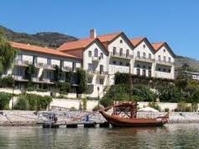 landscape of terraced vineyards that inch their down steep slopes to the water’s edge. Nestled in this splendid scenery is the Hotel Vintage House, a 42 room inn carved out of a former 18th century wine estate. The overall décor reflects the mood of an English manor house, and the guest rooms, each with a glorious river view, are comfortable without being over-the-top luxurious. The nighttime silence is so profound that one might as well be slumbering on another planet (or in an earlier, quieter century). I didn’t dine at the hotel this time (I went to the much acclaimed Restaurant DOC a few miles downriver), but I’ve had excellent meals at Vintage House in the past. This is, of course, Porto wine country, and the hotel staff will help arrange wine tastings and/or wine related expeditions on the river. landscape of terraced vineyards that inch their down steep slopes to the water’s edge. Nestled in this splendid scenery is the Hotel Vintage House, a 42 room inn carved out of a former 18th century wine estate. The overall décor reflects the mood of an English manor house, and the guest rooms, each with a glorious river view, are comfortable without being over-the-top luxurious. The nighttime silence is so profound that one might as well be slumbering on another planet (or in an earlier, quieter century). I didn’t dine at the hotel this time (I went to the much acclaimed Restaurant DOC a few miles downriver), but I’ve had excellent meals at Vintage House in the past. This is, of course, Porto wine country, and the hotel staff will help arrange wine tastings and/or wine related expeditions on the river.
The Yeatman: Each of the 82 guest rooms at this classy hotel has a private terrace with expansive views of the city of Porto stretching out seductively across the Douro River. From its commanding hillside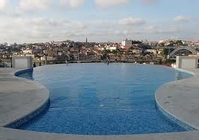 position on the south side of the river, the Yeatman seems to float above the red tiled roofs of Vila Nova de Gaia’s legendary “lodges” where Port wines are stored for aging. The hotel’s mood and décor reflects the dual sensibilities and traditions of the Portuguese and British cultures that established the country’s wine culture. At the Yeatman, which opened in August 2010 and was founded by the Fladgate Partnership (the owners of Taylor’s, Fonseca and Croft Port houses), wine is definitely the theme, from the Caudalie Vinotherapies Spa, to the decanter-shaped infinity pool. The hotel’s 25,000 bottle wine cellar stocks the world’s largest range of Portuguese wines, and each of the spacious, light, bright guest rooms is affiliated with a specific winery “partner” who has helped personalize the room. And did I mention that the Yeatman’s beds are incredibly comfortable? position on the south side of the river, the Yeatman seems to float above the red tiled roofs of Vila Nova de Gaia’s legendary “lodges” where Port wines are stored for aging. The hotel’s mood and décor reflects the dual sensibilities and traditions of the Portuguese and British cultures that established the country’s wine culture. At the Yeatman, which opened in August 2010 and was founded by the Fladgate Partnership (the owners of Taylor’s, Fonseca and Croft Port houses), wine is definitely the theme, from the Caudalie Vinotherapies Spa, to the decanter-shaped infinity pool. The hotel’s 25,000 bottle wine cellar stocks the world’s largest range of Portuguese wines, and each of the spacious, light, bright guest rooms is affiliated with a specific winery “partner” who has helped personalize the room. And did I mention that the Yeatman’s beds are incredibly comfortable?
Posted by Marguerite Thomas at 5:38 AM
|
|
May 12, 2011
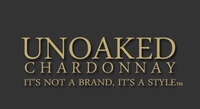 Spring is bringing warmer weather all across the northern hemisphere, with predictable results: Meals are turning lighter and fresher, and so are the wines that work best with them. Spring is bringing warmer weather all across the northern hemisphere, with predictable results: Meals are turning lighter and fresher, and so are the wines that work best with them.
To be sure, spring and summer can still include hearty meals involving items like grilled steaks, and they can taste very good with hearty wines like Cabernet or Zinfandel almost regardless of the ambient temperature. Still, the fact remains that lighter food become more prominent as temperatures rise, and lighter wines with greater refreshment value rise in tandem for most consumers.
Most wine lovers are well aware of this, but those who don’t watch industry trends might not be aware of a general uptick in global appreciation of lighter, more delicate wines in recent years. Here are a few telling indicators:
 Exhibit One, The Pinot Grigio Boom: Pinot Grigio was no big deal a decade ago, but now it has surpassed Chardonnay as the leading imported varietal wine in the United States. Now, if you’ve had a chance to taste a fair number of Pinot Grigios, you’ll know that they don’t have a lot of flavor or character or body or alcohol or oak. In fact, the whole point of Pinot Grigio is not what it is but what it isn’t: It isn’t heavy, it isn’t oaky, and it isn’t Chardonnay. It sells like crazy, and does so almost solely on the strength of being light and refreshing. Exhibit One, The Pinot Grigio Boom: Pinot Grigio was no big deal a decade ago, but now it has surpassed Chardonnay as the leading imported varietal wine in the United States. Now, if you’ve had a chance to taste a fair number of Pinot Grigios, you’ll know that they don’t have a lot of flavor or character or body or alcohol or oak. In fact, the whole point of Pinot Grigio is not what it is but what it isn’t: It isn’t heavy, it isn’t oaky, and it isn’t Chardonnay. It sells like crazy, and does so almost solely on the strength of being light and refreshing.
Exhibit Two, The Pinot Noir Boom: Yes, it is probably true that “Sideways” had a role in the ongoing Pinot Craze, but the movie is only sufficient to explain why some consumers took a first taste of Pinot--not why they seem to keep coming back to it despite its lightness relative to Cabernet or Shiraz. Pinot continues to ride high on a wave of popularity and, as with Pinot Grigio, it seems clear that it is succeeding because of--not despite--its lightness.
Exhibit Three, Un-wooded Chardonnay: Can you think of another case in which a wine (or any product, for that matter) is marketed on the basis of something that has not been done to it? Explicitly un-wooded Chardonnays debuted about six or seven years ago in Australia, which had formerly been the worst offender among Chardonnay producing countries in making whoppingly oaky, gooey Chards.
This lends credence to the notion that un-wooded Chardonnays are part of a wider backlash, and the backlash has now spread to many other countries such as New Zealand, Chile, South Africa and the USA. Moreover, many of those Chardonnays that are still fermented or aged in barrels now see much lower percentages of new wood, or are exposed to less aggressively toasted casks, or stay in them for a shorter period of time.
The Upshot: There’s still plenty of demand for Whopping Zins and Killer Cabs, but today’s consumers are far more respectful of lighter, more delicate wines than their counterparts tended to be a decade ago. There’s no “Party Line” here on Wine Review Online, but many of our writers have been extolling the virtues of this style for years, both because of its intrinsic merit and also because wines in this style prove so versatile at the table.
So, if you are about to make a seasonal shift to lighter wines, you might ask yourself: Should this be a merely seasonal shift, or a more enduring one?
Posted by Michael Franz at 11:44 AM
|
|
May 11, 2011
When it comes to long-term wine storage, the three most important things to consider are light, humidity, and temperature.
Let’s start with light. The reason to be concerned if too much light strikes the bottles being laid down for future enjoyment is that UV rays can ultimately damage wine, especially lacy, delicate wines. This is why premium wine is almost always packaged in light-inhibiting tinted bottles (and why Cristal Champagne comes with a protective anti-UV wrapper around its clear glass bottle). Wine is traditionally stored in the dark, but in truth there isn’t much evidence to prove that low, non-UV light causes damage.
As for humidity, it’s long been suggested that excessively dry air can cause corks to dry out and shrink away from the sides of the bottle, leading to oxidation and other spoilage from air seeping into the wine. Of course the corks are protected to some extent by the foil capsule, but since I’ve had personal experience with crumbling corks in dry desert climates, I’m inclined to believe in the value of humidity control (incidentally, one reason wine experts typically advise against storing wine long-term in the fridge is because of concern that a refrigerator’s dehumidifying cycles might eventually damage the corks).
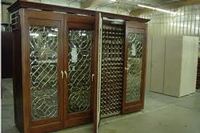 One thing everyone seems to agree on is that the most crucial factor concerning wine storage is temperature. Wine is remarkably affected by the ambient temperature: High temperatures accelerate aging, low temperatures slow down the maturing process, while long stretches of exposure to extreme temperatures can apparently produce undesirable chemical changes in the wine. One thing everyone seems to agree on is that the most crucial factor concerning wine storage is temperature. Wine is remarkably affected by the ambient temperature: High temperatures accelerate aging, low temperatures slow down the maturing process, while long stretches of exposure to extreme temperatures can apparently produce undesirable chemical changes in the wine.
Most experts suggest 55-60F (11-13C) as the ideal temperature for wine storage. (Tom Stevens, in The Sotheby’s Wine Encyclopedia, believes 52F, or 11C, is just about right). There’s no doubt that chilly works best, but almost more important than the actual temperature is that it be constant, for temperature fluctuations are known to play havoc with wine that is meant to be slumbering for the long haul.
So where should you lay your wine down to ensure graceful aging? The wine storage unit business, an impressive growth industry, offers innumerable options to consumers who want to store anything from a single bottle up to several hundred cases in temperature-controlled environments. Some wine collectors rent an off-premise commercial storage facility designed for the purpose, others use a simple, dark closet or other comparment dedicated to holding wine. If you happen to have access to an underground cave that’ll work, for cave temperatures are notoriously hospitable to wines.
But here’s another idea: how about storing your wines at the bottom of the sea? Recent hauls from shipwrecks seem to indicate that the ocean floor may just be the most ideal place to store wine, especially Champagne. The most stunning example of this theory put to practice was the discovery last year of at least 30 bottles of Champagne lying in the wreckage of a sailing vessel 180 feet (55 meters) under the Baltic Sea.
Christian Ekstrom, who led the team of seven Swedish divers that recovered the cargo, reported that since the underwater visibility was so poor he brought one of the bottles up to the surface to help establish the date of the wreck. Of course the divers popped the cork to have a taste, and discovered to their amazement that it was a sparkling wine. According to Ekstrom, it still had fizz, and it tasted sweet and “fantastic.”
The considerable detective work that followed established that the wine was almost certainly Veuve Clicquot, and was made sometime between 1782 and 1788. According to one wine expert who tasted it, the wine had plenty of bubbles, was a dark golden color, and had an intense aroma, some fruit and some acidity, as well as the considerable sweetness typical of Champagne from that era.
It is certainly the oldest drinkable Champagne known. There is impressive evidence that it was part of a consignment sent by King Louis XVI to the Russian Imperial Court. Current speculation is that the opening price at auction for each bottle may be around $69,000.
Not all undersea wine storage is accidental. Vina Casanueva, a Chilean winery, produces a line of wines that are stored intentionally on the seabed. Patricio Casanueva, the winery’s general manager, maintains that the combination of pressure and constant temperature make ideal wine storage conditions for his estate’s Cabernet and Muscat-Chardonnay wines. The perfect wine to serve with fish, perhaps?
Posted by Marguerite Thomas at 1:59 PM
|
|
May 10, 2011
Tannins in red wine are something we feel, not taste. Sadly, too few wine drinkers get to feel them these days. So where have they gone?
Ever since the advent of wines that did not deteriorate rapidly (because they were sealed securely in glass bottles), people have savored the sensation imparted by tannins. That first happened in the early eighteenth century. And it happened because winemakers and wine drinkers understood that the firm, sometimes pasty, tactile sensations imparted by tannins give red wines structure. Tannins help prevent wines from feeling flaccid or flabby. They function much like the keystone in an arch or the keel in a ship’s hull, holding everything together in successful alignment.
Tannins also serve another function. Since they can precipitate over time, their presence allows a red wine that feels harsh when young to feel softer and gentler after time spent in bottle. That same wine then may develop subtle, nuanced secondary (i.e., not primary fruit) flavors, becoming more complex and so more compelling. In short, tannins are the primary chemical compounds that enable some red wines not just to endure but actually to evolve and improve over time. They make aging wine possible.
So why are so many contemporary red wines deficient in the sensations imparted by tannins? The answer is not that people no longer cellar and age wines. Buying wine and holding onto it for years before drinking it never has been a common activity. Even in the mid-nineteenth century, the golden age of aged red wines (particularly Bordeaux), only a small percentage of consumers owned cellars and drank old wines.
No, the real answer is that styles have shifted—away from astringency and defined structures, and towards pliability and cotton-candy softness. Contemporary winemaking technology has enabled this shift, just as the unprecedented influence exerted by certain influential critics has encouraged it.
The upshot is that “soft,” a disparaging descriptor just a generation ago, has become one of the highest terms of praise used by both winemakers and critics. A new generation of wine drinkers rarely experiences firm tannins, as seemingly everyone wants their red wines to feel soft nowadays.
The problem—and it is a problem—is that softness comes at a price, or prices. In order for a red wine truly to feel soft, the grapes have to hang long on the vine, producing high levels of sugar and, in the process, high levels of alcohol. Lacking the structure that tannins provide, those wines frequently feel fat and heavy when you drink them. And they often lack complexity, the ripe or often over-ripe taste of fruit overwhelming any subtle secondary flavors.
“Soft” admittedly can sound appealing when used to describe wine. But it can as well when talking about a mattress, even though a “firm” bed will most likely result in a better night’s sleep. With wine, the word “soft” actually more often than not denotes a simple, monolithic wine. It also frequently suggests saccharine-like sweetness. Precisely because so many “soft” wines lack a clear structure, they seem amorphous—which is perhaps the defining characteristic of today’s so-called “international style.”
The global shift in red-wine styles over the last decade or so has been accompanied by an equally notable shift in tastes (on the part of critics, consumers, and winemakers alike). The result is a bevy of structurally less satisfying red wines. This is true in the United States, Australia, and other New World counties to be sure, but also in France, Italy, Spain, and the rest of the Old World.
High quality red wines still need tannins—not primarily for aging, but rather for structure, harmony, and balance. So when styles and tastes shift again, as they surely will, tannins will be back. After all, they are a principal element in providing red wines with personality and character.
For now, however, we’re in the midst of a softness craze. That’s why savvy wine drinkers do well to remember the old Pete Seeger song: Where have all the tannins gone? Well, “long time passing.”
Posted by Paul Lukacs at 8:35 AM
|
|
May 6, 2011
It has been years, decades actually, since I experienced a Georgia summer. I remember the boiling sun by day and the steamy thunderstorms by night. I have no memory of sultry evenings spent sipping Georgia Roussanne. I am certain that I never spied a vineyard in Georgia during my frequent visits when I briefly worked as a journalist at a newspaper in North Carolina.
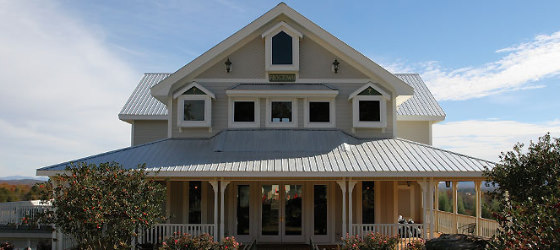 When I consider the wine regions of the world, Georgia — too hot, too humid — is never on my mind. Well, almost never. Georgia did spring to mind recently as I contemplated what I would consider unusual or surprising results from the many wine competitions I oversee. When I consider the wine regions of the world, Georgia — too hot, too humid — is never on my mind. Well, almost never. Georgia did spring to mind recently as I contemplated what I would consider unusual or surprising results from the many wine competitions I oversee.
A winery from Georgia, Frogtown Cellars, caught my eye as I scanned the results of the 2011 San Diego International Wine Competition, which was held in early April. Frogtown, a 57-acre wine estate situated in the foothills of the Appalachian Mountains, had won seven medals, five of them gold.
Winemaker and owner Craig Kritzer quickly shot me an email to say how thrilled he was. He was thrilled and I was stunned. I wondered how a winery from Georgia (that I had barely heard of) could mingle with the big boys in a major international wine competition and skate off with five gold medals.
Kritzer was more than happy to make the case for Georgia wine.
"Georgia is a surprise to most people in the wine business," he told me. "In my opinion, the premium grape growing region is quite small. The geologic area where Frogtown is located is called the Dahlonega Plateau.
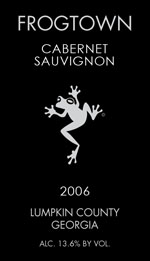 "This area is approximately one hour south of North Carolina. Elevations are no lower than 1,500 feet above sea level. Frogtown vineyard is planted on steep hillsides from 1,675 to 1,825 (feet of) elevation." "This area is approximately one hour south of North Carolina. Elevations are no lower than 1,500 feet above sea level. Frogtown vineyard is planted on steep hillsides from 1,675 to 1,825 (feet of) elevation."
He went on to explain that the growing season in and around the Frogtown estate is longer by at least two weeks than the viticultural area of nearby North Carolina. That extra time on the vine, Kritzer believes, enables Frogtown to produce red wines that possess more lush fruit and texture than is common for the reds of the southeastern United States.
"Yes, we are humid," he said. "I have learned over 13 years of growing grapes and making wine that I can deal with hydration but not unripe fruit. Most viticultural areas on the East Coast simply cannot ripen fruit to the degree necessary to make premium wines.
In most vintages, we have not had a problem in ripening Cabernet Sauvignon and Roussanne, the two latest ripening grapes we grow."
He added that Frogtown's conditions are similar in a couple of critical areas to those in California, arguably America's most successful location for viticulture.
"Frogtown's 'degree days' and 'chilling hours' are very similar to premium wine growing regions of California. Frogtown's overnight cool-down, while not as dramatic as (most) California regions, does cool down to below 70 degrees Fahrenheit, even when temperatures reach 90-plus degrees Fahrenheit during the day."
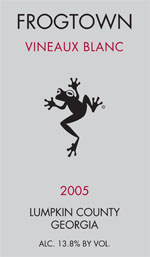 The evening cool-down is essential to the structure of a fine wine, particularly the red Bordeaux grape varieties that Frogtown produces. The cooling helps preserve acidity and freshness, which ultimately results in more elegant, refined wines. The evening cool-down is essential to the structure of a fine wine, particularly the red Bordeaux grape varieties that Frogtown produces. The cooling helps preserve acidity and freshness, which ultimately results in more elegant, refined wines.
"The 2006 Bordeaux varieties are very supple, possessing ample tannin," Kritzer says of his current release of reds. "In this manner, they are similar to very good Bordeaux, only possessing more fruit."
|
|
Posted by Robert Whitley at 1:48 PM
|
|
May 4, 2011
With Mother’s Day, graduation parties, wedding season, and Father’s Day all bearing down on us, countless people are quaking at the prospect of having to pick wines to pair with meals for an impending Big Occasion.
My advice? Fear not. Getting tasty, workable matches between wines and foods is actually not very difficult--despite that fact that this task  has traditionally been over-legislated and treated with absurd fussiness. has traditionally been over-legislated and treated with absurd fussiness.
Note that I am addressing “tasty, workable” matches rather than “amazing, life-transforming” ones. Truly drop-dead-perfect matches involve interplay between little flavor nuances that require precise knowledge of a particular wine, plus all the ingredients and preparation factors in the food.
However, if you are simply hosting a dinner or a party, you need only come up with nice matches--not earth shattering ones.
And guess what? The happy fact of the matter is that you can achieve a very high rate of success when pairing wines with foods by forgetting one thing and remembering two others:
1) Forget Color: The old rule of pairing white wines with fish and red with meat will, if you think about it, often run afoul of the rule of getting robustness in balance. The fact is that a thick, grilled tuna steak is more robust than thin, sautéed slices of veal tenderloin. Many people will find that a light red like Pinot Noir works much better than a white with that tuna steak, just as a substantial white may be a better choice than a red for the veal.
2) Get Robustness in Balance: A good marriage between wine and food entails an equal partnership in which neither participant dominates the other. If the wine overwhelms the food (as Cabernet overwhelms oysters), the result is a failure. If the wine cannot hold its own with the food (as Sauvignon Blanc cannot hold up to steak), it cannot contribute to an enjoyable match. Balance is our goal, but what exactly are we trying to balance? The robustness of the food and the wine. That is, the sheer “size” and flavor impact of the two must be roughly symmetrical for a good match. This is not so hard to achieve. Anybody who eats can distinguish the differing robustness levels of different foods, and even a novice taster needs just a sip to learn that certain grapes and growing regions produce “bigger” or “smaller” wines that can be sized appropriately to any dish.
3) Tend to Texture: Wines differ from one another in texture, and the texture of a wine isn’t quite the same as its sheer “size.” For example, a Shiraz or Zinfandel can be just as “big” as a Cabernet Sauvignon while nevertheless being much “softer” or “rounder” in texture. Foods also differ quite importantly in texture, and this variable really makes a difference in getting great results from pairings. Interesting textural matches can be either complementary or contrasting. For example, a rich dish like lobster with drawn butter can be matched successfully with a soft, “buttery” Chardonnay that complements its texture, or with a leaner, more “edgy” dry Riesling that offers a textural contrast. If you simply pay attention to texture when making a trial run with your dinner and a promising wine or two, you’ll find it easy to pick the wine that offers the most pleasing pairing.
There’s more to wine pairing than these simple tips, but if you follow them, you’ll not only get through any party that’s looming on your horizon, but do so with enough success to build confidence for more ambitious adventures in the future.
Posted by Michael Franz at 8:17 AM
|
|
May 3, 2011
Nicolás Catena is widely acknowledged to be the father of contemporary Argentinean wine. He inspired first his native Mendoza region, and then his entire country, to aim for a higher level of wine quality than anyone previously had imagined possible. Today, whether with value-priced brands like Alamos, or the premium-priced, world-class wines produced under his own Catena Alta and Catena Zapata labels, he continues to lead Argentina’s ongoing wine revolution.
Dr. Catena (he holds a PhD in economics) started in his father’s footsteps, but then went his own way. Back in the 1960s and 1970s, Domingo Catena, himself the son of a winemaking Italian immigrant, was a leading producer of old-fashioned (meaning, oxidized) wines for the domestic Argentinean market. Beginning in the mid-1980s, Nicolás turned the family business upside down, producing ever cleaner, fresher, and more compelling varietal wines, and then selling them 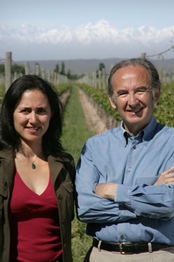 internationally. His success turned heads far and wide, bringing new energy, new money, and new vision to Argentinean grape growing and winemaking. internationally. His success turned heads far and wide, bringing new energy, new money, and new vision to Argentinean grape growing and winemaking.
A new generation is now taking over. As I suspect many readers already know, Nicolás’ daughter, Laura (also a doctor, in her case an emergency room physician), has taken the reins at the family winery, while also running her own operation, Luca. With both endeavors, she quite consciously pays homage to her father’s achievements, building upon his ground-breaking legacy.
Things are a bit more complicated with Nicolás’ son, Ernesto. Rather than work alongside his father and sister, he has gone off on his own, with projects like Tikal, Siesta, and Alma Negra. Yet much like them, he is committed to excellence, and the wines from Ernesto Catena Estates rank among Argentina’s best. A recent visit to his Tikal property to sample the Alma Negra releases made that abundantly clear.
Something of an iconoclast, Ernesto has read extensively in mystic literature and philosophy. He raises llamas to roam his vineyard, has designed a rose garden in lunar alignment, and constructed an extensive vine-labyrinth next to his winery, a place where he says he wants people to “lose themselves and get to know their souls.” Yet, lest you pigeon-hole him as a clichéd free spirit, he also is an avid polo- player, and evidently a fairly shrewd businessman. A software developer, book publisher, and designer, he owns an art gallery as well as a wine bar in Buenos Aires. And of course, he also runs a fast-growing wine business. player, and evidently a fairly shrewd businessman. A software developer, book publisher, and designer, he owns an art gallery as well as a wine bar in Buenos Aires. And of course, he also runs a fast-growing wine business.
A proponent of biodynamic viticulture (though he sources plenty of conventionally-grown grapes), Ernesto Catena talks about wine in almost spiritual terms. He insists that, like anything of true value, good wine must contain an element of mystery. Two of his best wines are in fact called “Misterio.” Sold under the Alma Negra label, these are red blends of uncertain varietal origin, but unquestioned class and pedigree. The 2006 “Gran Misterio” ($90), in particular, tastes simply stunning. It in fact was the second best wine I tasted on my trip to Argentina, ranking only behind (what else?) his father’s top of the line 2007 Nicolas Catena Zapata.
I have not sampled all of Ernesto Catena’s wines, but other standouts among those I have tried include Alma Negra’s 2010 Viognier ($24) and 2008 Pinot Noir ($30), as well as Tikal’s 2009 “Patriota” ($20, a Bonarda and Malbec blend ). From now on, though, I definitely will be on the lookout for more. Chatting with this gentle yet driven man, it was admittedly difficult to tell how much of his talk of wine’s inherent mystery was conviction and how much hype. Yet there was no doubting the quality in the glass. In his language and world view, Ernesto Catena seems quite unlike his father, whose approach to his business remains much more analytic. Yet in his commitment to world-class Argentinean wine, he clearly is very much his father’s son.
(Wines under the Alma Negra label are imported to the United States by Winebow; the Siesta line is imported by Domaine Select, and Tikal by Vine Connections.)
Posted by Paul Lukacs at 6:46 AM
|
|
May 2, 2011
Forget the formulaic brunch, and for god’s sake don’t just blow Mom off with a silly card and/or hurried phone call. This year plan to celebrate Mothers’ Day with something you’ll both enjoy: a visit to a local winery. Many wineries, from sea to shining sea, are offering something special on May 8, from Alba Vineyard (New Jersey) which is offering a Mother’s Day tasting lunch plus live music and a special etched wine glass, to Zaca Mesa (California), where you can treat your mom to a “Hike & Blend” day with the winemaker, picnic lunch included.
Does Mom like chocolate? Of course she does! For a Mother’s Day wine & chocolate pairing take her to Lone Oak Vineyards in Michigan, Sugarloaf Vineyards in Virginia, or Grove Winery in North Carolina. If spring blooms are her thing she’s going to love the Mother’s Day professional flower arranging class at Long Island’s Sparkling Pointe, particularly since a flute of that estate’s fine bubbly is included in the deal. And speaking of sparkling, how about trying the red fizz at Maryland’s Serpent Ridge? Okay, if you’d rather have one of their Cabernets with your filet mignon dinner at Serpent Ridge’s Mothers’ Day dinner, that’s fine with me too. Hot Mama Fashionistas will find a five course Mother’s Day gourmet meal and fashion show at Pennsylvania’s Crossing Vineyards a fitting celebration (pun intended). Lucky New York moms, meanwhile, can enjoy brunch and wine while they tap their toes to the rollicking strains of the Metropolitan Klezmer Band at City Winery.
This list is just the tip of the iceberg, meant simply to whet your appetite for the occasion. Get on the Internet and do a little research, for wherever you live there is apt to be a winery near you ready to pour a memorable Mother’s Day. Your mother will thank you--and if you include your grandmother in the festivities, she’ll thank you too! And while we’re at it, let’s remember to raise a glass to mothers everywhere….
Posted by Marguerite Thomas at 10:11 AM
|
|
 |
|